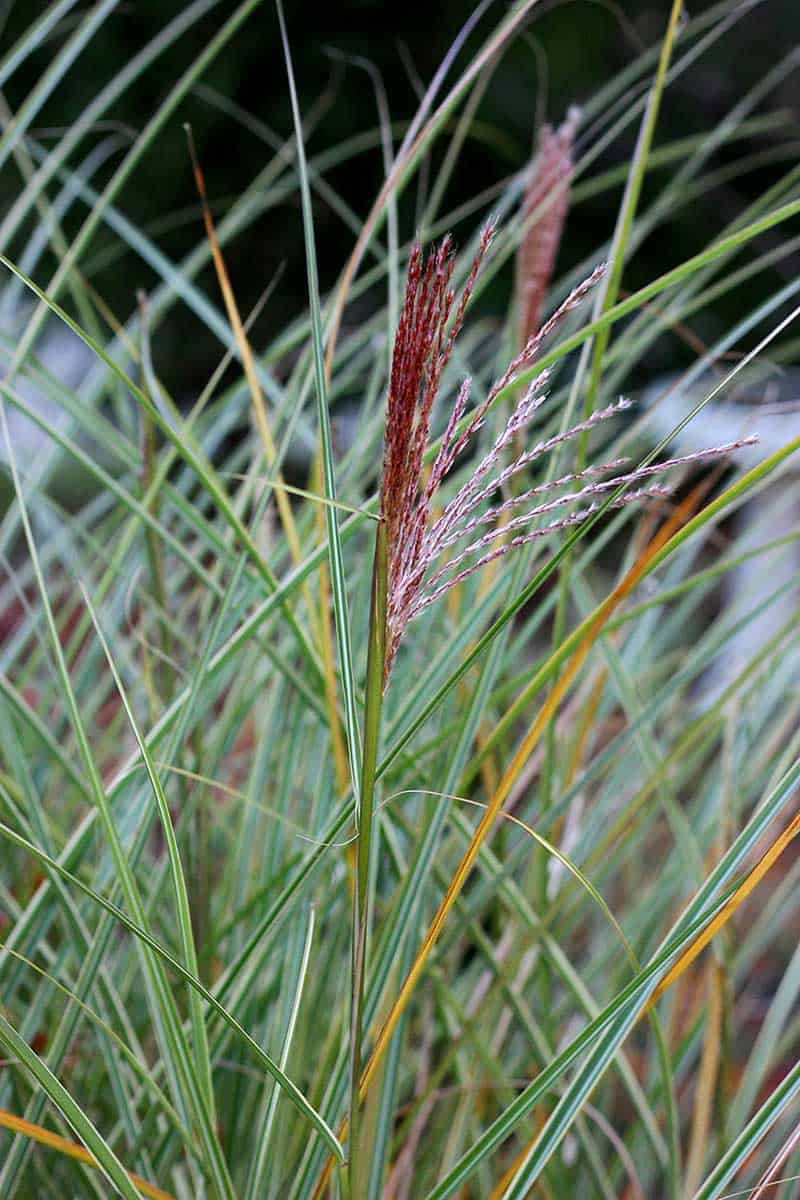
I’m glad to have both roses and ornamental grasses in the front garden, where they continue to bloom and prolong the seasonal display. It never occurred to me that they would possibly be most appreciated in autumn, when so many other perennials and shrubs are finished blooming. The one rose shrub is fluorescent red Double Knock Out, back in bloom now that the Japanese beetles have finished feeding. The grasses are Foerster’s feather reed grass (Calamagrostis x acutiflora ‘Karl Foerster’, Zone 4), ‘Morning Light’ maiden grass (Miscanthus sinensis ‘Morning Light’, Zone 5), variegated dwarf Moor grass (Molinia caerulea ssp. caerulea ‘Variegata’, Zone 4) and ‘Strictus’ porcupine grass (Miscanthus sinensis ‘Strictus’, Zone 5). These are a predictable quartet for my Zone 6a region, frequently seen mass planted in public gardens or in raised planters outside offices and condominiums. I won’t get any awards for adventurous selection, but I know they will always put on a good summer display and stand through autumn and into winter.
Garden centres and specialist online nurseries (bluestem.ca) offer a generous number of ornamental grasses, and choices are usually based on available space, colour and form. But to my mind, the two primary criteria are: is the grass clump forming or does it have running roots; and is it a cool-season or warm-season grass?
Clump-forming grasses expand and thicken their root mass, and remain reliably in place. With age, they sometimes develop a dead centre, with the most vigorous areas left in a ring around the perimeter. They’re easily divided in autumn by taking sections from the outer ring.
Grasses with running roots won’t stay in place, and their roots run underground to colonize new territory. Some are slow spreaders, such as snowy wood rush (Luzula nivea, Zone 5), with fuzzy green arching leaves that slowly spreads in part sun to light shade and makes clusters of showy white flowers in summer. Its fibrous root system can eventually form a weed-resistant groundcover. Variegated wood rush (L. sylvatica ‘Marginata’, Zone 5) is another slow spreader with narrow creamy white edges to the leaves and insignificant flowers. Fast-running grasses, like green-and-white canary grass (Phalaris arundinacea var. picta ‘Picta’), also known as ribbon grass and gardener’s garters, seem to spread faster than a speeding bullet, and perhaps are best constrained in containers sunk into the ground. The many forms of bamboo are spreading grasses, too, and some are aggressive colonizers. Needless to say, be sure you know if the ornamental grass you select is a clump former or a spreader.
Cool-season grasses begin their spring growth as soon as air temperatures are above freezing. (Cut down the previous season’s stems in late autumn to avoid damaging the early new growth.) Their early start gets them to blooming mode by midsummer, guaranteeing their blooms won’t be ruined by frost in short growing season regions. Many cool-season grasses provide a long season of bloom and keep their flower tassels in good condition all the way to winter. My ‘Karl Foerster’ feather reed grass and variegated Moor grass are both cool-season grasses, showing their flower sprays in July, and are still in excellent condition.
Warm-season grasses, such as pennisetum and miscanthus, begin spring growth when the soil warms, and come into their bloom period in autumn. In northern hardiness zones with short growing seasons, the blooms may not entirely develop before hard frost shuts the plants down. That has happened with my clumps of ‘Morning Light’ miscanthus when an earlier than usual hard frost has put an end to the flower display just as it was beginning. Fortunately, most years the warm-season grasses in my garden do get their tassel-like blooms out and I can enjoy them even when the snow flies. But it’s always a gamble when gardening in the north.
You may also be interested in:









I enjoy your magazine very much. Only one irritant: so few photos. You mention all of sorts of plants, e.g., article on ornamental grass refers to different kinds, but there’s no visual. Recommendation: show AND tell, always. Makes for happy readers.
Many thanks.